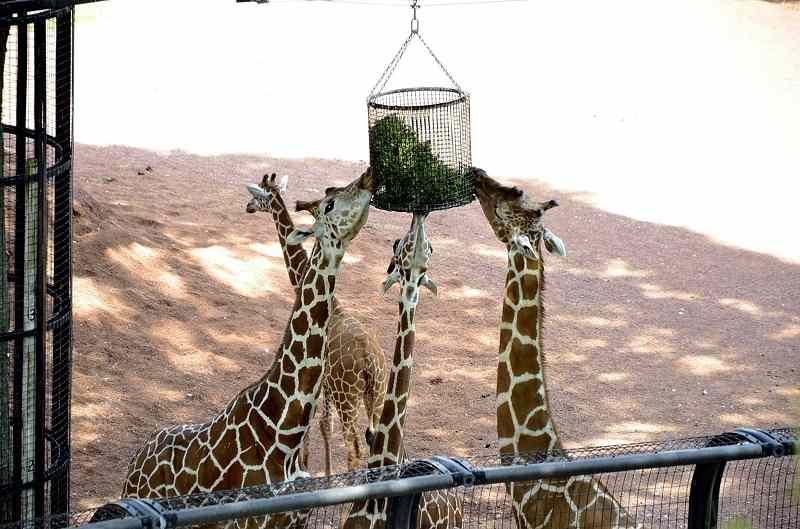
Giraffes eat food from high-hanging baskets at Tama Zoological Park in Hino, Tokyo, on Aug. 9.
13:13 JST, September 18, 2022
Zoos and aquariums nationwide are reexamining how they exhibit animals in their care and how visitors are allowed to interact with the animals, so as to reduce stress on the captive creatures.
These efforts stem from the concept of animal welfare, which emphasizes the need for animals to live in their natural habitats.
Discontinuing animal shows
In early August, when a dolphin jumped and splashed back into the water at the Shinagawa Aquarium in Shinagawa Ward, Tokyo, families crammed into the auditorium during their summer vacation shouted with delight.
The dolphin show has been a popular feature since the aquarium’s opening in 1991, but the ward decided in May that the show would be discontinued alongside the renewal of the aquarium in fiscal 2027.
An animal protection group had sent in a petition accompanied by many signatures complaining that keeping the animals in the narrow, shallow pool for a show is abusive.
“There were many who regretted the decision to discontinue the show, but we took into consideration the concept of animal welfare,” said Tomoyuki Takanashi, head of the ward’s parks division.
In June, Sapporo passed the nation’s first municipal zoo ordinance following the death of a female sun bear in a fight with a male at the Maruyama Zoo, a popular zoo in the city.
The ordinance called for the creation of a breeding environment in which animals could live without stress or pain. As a general rule, it prohibits visitors from touching the animals in the zoo’s care.
Extending life spans
Zoos and aquariums have recently been creating more opportunities for visitors to directly interact with animals, not only through observing animal exhibits but also through touching and feeding experiences.
However, the World Association of Zoos and Aquariums, headquartered in Switzerland, issued guidelines in 2015 that declared the necessity of ensuring animals’ psychological well-being, given that animals may exhibit threatening behavior due to discomfort or stress.
In light of the fact that insufficient efforts by zoos and aquariums in Japan could hinder the procurement of animals from overseas, the Japanese Association of Zoos and Aquariums also established standards for appropriate facilities for each animal in September 2020.
Tama Zoological Park in Hino, Tokyo, which constructed new housing for three Asian elephants in August last year, has adopted these standards, creating an area five times larger than the previous one and separating the areas for females and males to suit the females’ habit of forming groups with their offspring.
Gravel has been placed in the park’s zebra enclosure so that their hooves can wear down naturally. The park also hangs giraffes’ food baskets at a height that allows them to stretch their long necks and eat comfortably.
“If we provide a comfortable living environment, the animals’ life spans can be prolonged,” said Shoji Toyoshima, director of the park’s education division.
Seeking balance
On the other hand, shows and interactive experiences with animals also serve to deepen children’s understanding of living creatures. Zoos are searching for ways to make the experience more enjoyable for visitors without stressing the animals.
In August 2018, Kyoto City Zoo prohibited visitors from picking up guinea pigs. Instead, the zoo allows visitors to stroke the backs of the guinea pigs, which now have plastic tubes in their boxes so that they can escape into the tubes at any time.
“We want to devise ways to increase the educational effect while incorporating animal welfare,” an official of the zoo said.
In April, Osaka Tennoji Zoo renovated a facility where visitors can feed and interact with sheep and goats, and afterwards it introduced a new system that allows people to feed sheep and goats only three times a day and by appointment only, because the sheep sometimes became ill after eating too much food.
“Emphasis on animal welfare is now a global trend. The number of facilities in the nation that are proactive about animal welfare is increasing. I think this trend will only get stronger,” said Yoichi Sadotomo, a lecturer of zoo science at Teikyo University of Science.

Gravel is placed in the zebra enclosure so that their hooves can be trimmed naturally, at Tama Zoological Park in Hino, Tokyo, on Aug. 9.
"Science & Nature" POPULAR ARTICLE
-

Genome Study Reveals Milestone in History of Cat Domestication
-

Big Leap in Quest to Get to Bottom of Climate Ice Mystery
-

Security Camera Footage Vulnerable to Outside Access; Investigation Finds 3,000 Pieces Exposed Online
-

Japan Set to Participate in EU’s R&D Framework, Aims to Boost Cooperation in Tech, Energy
-

Paws on Parade: Nairobi’s Dogs Dazzle at ‘Pawchella’
JN ACCESS RANKING
-

Tokyo Economic Security Forum to Hold Inaugural Meeting Amid Tense Global Environment
-

Keidanren Chairman Yoshinobu Tsutsui Visits Kashiwazaki-Kariwa Nuclear Power Plant; Inspects New Emergency Safety System
-

Imports of Rare Earths from China Facing Delays, May Be Caused by Deterioration of Japan-China Relations
-

University of Tokyo Professor Discusses Japanese Economic Security in Interview Ahead of Forum
-

Japan Pulls out of Vietnam Nuclear Project, Complicating Hanoi’s Power Plans
























